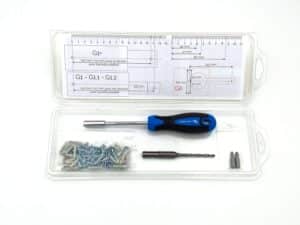151,50€ w/o VAT per box 10 units

Technical specifications
|
||
How to fix the gauge?In order to most effectively measure the evolution of the crack, the gauge is usually attached at the widest point of the crack or in the middle of the crack. The G1+ gauge is made of a material that is flexible enough to accommodate and follow the movement of irregular, convex or concave surfaces. There are two possible methods of fixing:
A: Impact anchors |
||
Installation tips
Ideally, position the vernier triangle between 33 and 34 with the two speckled bands appearing on the right and left. The objective is to centre the pull tab. The principle consists in measuring the difference between 2 measurements: it does not matter the value of the first measurement, it is it which will constitute the 0 point.
Position the pin of the folding bar in the middle of the slotted hold to absorb any movement.
|
||
How to measure the crack evolution in a vertical or horizontal internal angle?It is possible to fix the gauge in angle : G1 family gauges are supplied with a foldable plastic angle bar. Examples of corner installation:
|
||
How to protect G1+ crack monitor?
In high-traffic areas where there is a high risk of damage, the removable E1 crackmeter can be used with transparent plates. After measurement, only the plates remain on the support, preventing any possible damage. |
||
How to read the G1+ gauge ?The major innovation provided by the G1+ gauge resides in its “digital” readout of tenths of mm: indeed, each 1/10 mm movement of the pull tab causes the concomitant obstruction of a row of 6 white lights placed on this same tab. Each row is assigned to a digit (0 to 9) corresponding to the tenths of mm.
By subtracting the first from the second reading, we can infer that the crack has grown by 0.55 mm in a little more than 3 months. The vernier, located on the top of the pull tab, will confirm these results if necessary (for instructions on reading the vernier, see the G1 gauge product sheet) |
||
Download the Saugnac.app application to monitor your measurementsThe Saugnac web application, which is completely free of charge and has no limitations, is available on PC or smartphone from https://saugnac.app. It allows you to :
Find all the explanations on how the application works |
||
Download monitoring Excel file
This Excel file is very easy to use: you just have to duplicate a sheet for each site or construction site observed with the possibility to follow up to 10 gauges. Note that the impact of the expansion coefficient on the G1+ gauge measurement is very small (about 9 micrometers every 1°C). Here is an example of the type of monitoring obtained with the file:
|

Protection with anti-UV filter for G1 gauges fixed outside (delivered with impact anchors)

Fast-curing epoxy adhesive in a twin-syringe for reinforced bonding in cases of significant surface roughness or high moisture

Mechanical fixing kit for surfaces unsuitable for self-adhesive installation (includes 1 drill bit + 1 PZ1/PZ2 screwdriver + 40 wall plugs and screws)

Bag of 50 anchors and screws for mechanical fixing on surfaces unsuitable for self-adhesive mounting

For measuring the variation in a crack in a vertical or horizontal internal angle (with self-adhesive tabs and 1 impact anchor).
Pour obtenir un devis ou nous poser des questions sur le produit, n’hésitez pas à nous contacter :
If you would like a quotation or have any questions about the product, please contact us: